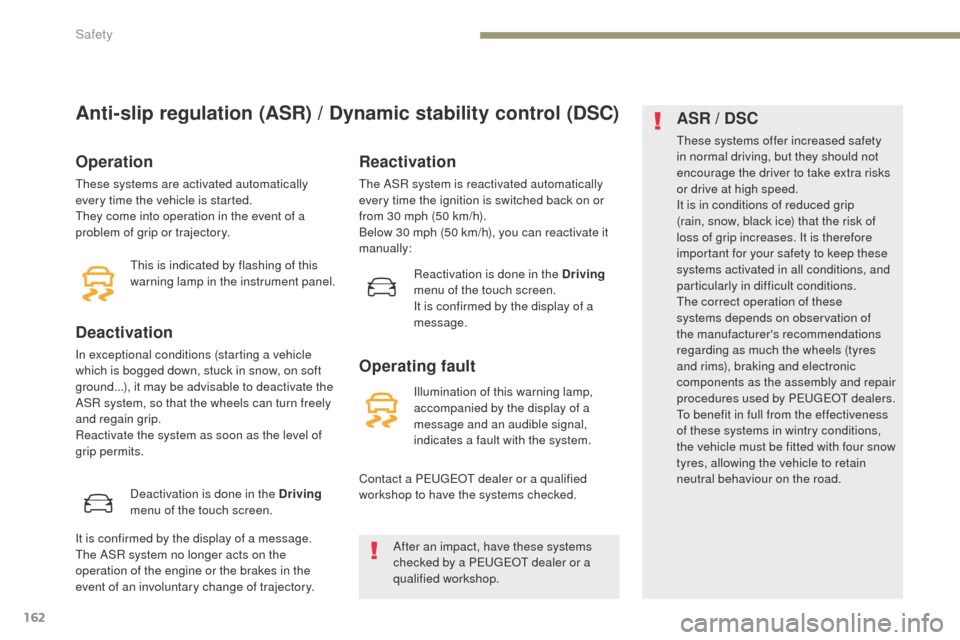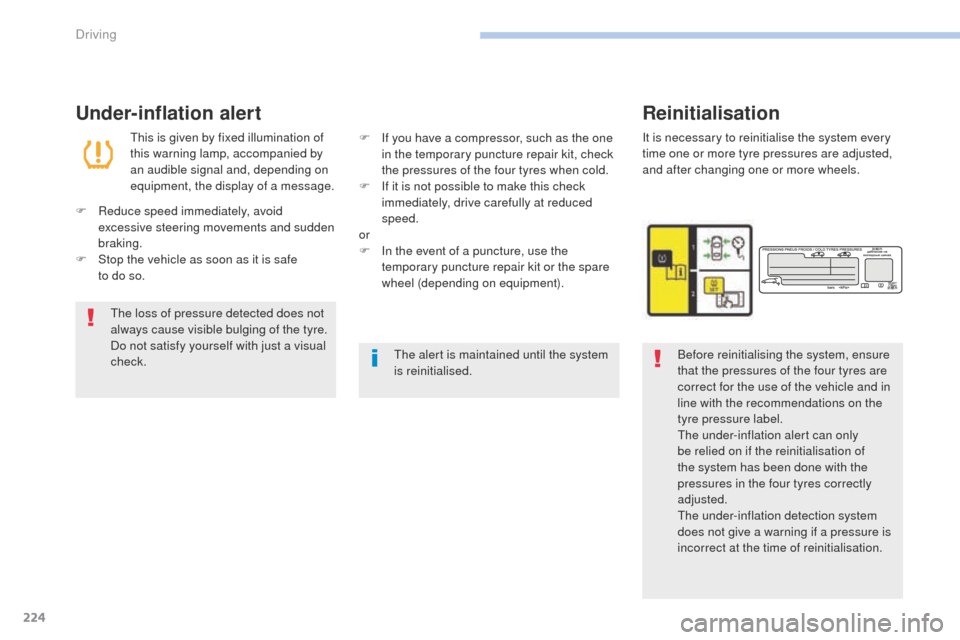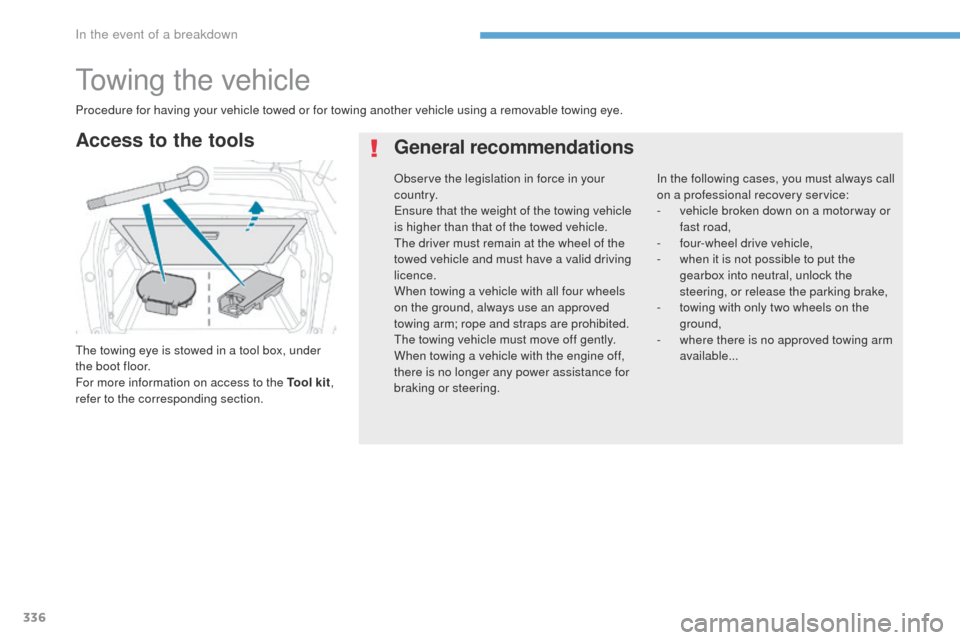Page 164 of 566

162
3008-2_en_Chap05_securite_ed01-2016
Anti-slip regulation (ASR) / Dynamic stability control (DSC)
Operation
These systems are activated automatically
every time the vehicle is started.
They come into operation in the event of a
problem of grip or trajectory.
Deactivation
In exceptional conditions (starting a vehicle
which is bogged down, stuck in snow, on soft
ground...), it may be advisable to deactivate the
ASR system, so that the wheels can turn freely
and regain grip.
Reactivate the system as soon as the level of
grip permits.Deactivation is done in the Driving
menu of the touch screen.
Reactivation
The ASR system is reactivated automatically
every time the ignition is switched back on or
from 30 mph (50 km/h).
Below 30 mph (50 km/h), you can reactivate it
manually:
Operating fault
This is indicated by flashing of this
warning lamp in the instrument panel.
Illumination of this warning lamp,
accompanied by the display of a
message and an audible signal,
indicates a fault with the system.
Contact a PEUGEOT dealer or a qualified
workshop to have the systems checked.
It is confirmed by the display of a message.
The ASR system no longer acts on the
operation of the engine or the brakes in the
event of an involuntary change of trajectory.
ASR / DSC
These systems offer increased safety
in normal driving, but they should not
encourage the driver to take extra risks
or drive at high speed.
It is in conditions of reduced grip
(rain, snow, black ice) that the risk of
loss of grip increases. It is therefore
important for your safety to keep these
systems activated in all conditions, and
particularly in difficult conditions.
The correct operation of these
systems depends on observation of
the manufacturer's recommendations
regarding as much the wheels (tyres
and rims), braking and electronic
components as the assembly and repair
procedures used by PEUGEOT dealers.
To benefit in full from the effectiveness
of these systems in wintry conditions,
the vehicle must be fitted with four snow
tyres, allowing the vehicle to retain
neutral behaviour on the road.
After an impact, have these systems
checked by a PEUGEOT dealer or a
qualified workshop. Reactivation is done in the Driving
menu of the touch screen.
It is confirmed by the display of a
message.
Safety
Page 225 of 566

223
3008-2_en_Chap06_conduite_ed01-2016
Under-inflation detection
System which automatically checks the pressures of the tyres while driving.The under-inflation detection system
does not replace the need for vigilance
on the part of the driver.
This system does not avoid the need to
check the tyre pressures (including the
spare wheel) every month as well as
before a long journey.
Driving with under-inflated tyres impairs
road holding, extends braking distances
and causes premature tyre wear,
particularly under arduous conditions
(high loading, high speed, long journey).The inflation pressures defined for
your vehicle can be found on the tyre
pressure label.
For more information on the
Identification markings
, refer to the
corresponding section.
Driving with under-inflated tyres
increases fuel consumption.
The system monitors the pressures in the four
tyres, once the vehicle is moving.
It compares the information given by the four
wheel speed sensors with reference values,
which must be reinitialised ever y time the
tyre pressures are adjusted or a wheel
changed
.
The system triggers an alert as soon as it
detects a drop in the inflation pressure of one
or more tyres.
Snow chains
The system does not have to be
reinitialised after fitting or removing
snow chains.Checking tyre pressures
This check should be done when the
tyres are "cold" (vehicle stopped for
1
hour or after a journey of less than
6
miles (10 km) at moderate speeds).
Other wise, add 0.3 bar to the pressures
shown on the label.
6
Driving
Page 226 of 566

224
3008-2_en_Chap06_conduite_ed01-2016
It is necessary to reinitialise the system every
time one or more tyre pressures are adjusted,
and after changing one or more wheels.
Reinitialisation
This is given by fixed illumination of
this warning lamp, accompanied by
an audible signal and, depending on
equipment, the display of a message.
Under-inflation alert
F Reduce speed immediately, avoid excessive steering movements and sudden
braking.
F
S
top the vehicle as soon as it is safe
to
do so. F
I
f you have a compressor, such as the one
in the temporary puncture repair kit, check
the pressures of the four tyres when cold.
F
I
f it is not possible to make this check
immediately, drive carefully at reduced
speed.
or
F
I
n the event of a puncture, use the
temporary puncture repair kit or the spare
wheel (depending on equipment).
The loss of pressure detected does not
always cause visible bulging of the tyre.
Do not satisfy yourself with just a visual
check. The alert is maintained until the system
is reinitialised.Before reinitialising the system, ensure
that the pressures of the four tyres are
correct for the use of the vehicle and in
line with the recommendations on the
tyre pressure label.
The under-inflation alert can only
be relied on if the reinitialisation of
the system has been done with the
pressures in the four tyres correctly
adjusted.
The under-inflation detection system
does not give a warning if a pressure is
incorrect at the time of reinitialisation.
Driving
Page 338 of 566

336
3008-2_en_Chap08_en cas-de-panne_ed01-2016
Towing the vehicle
The towing eye is stowed in a tool box, under
the boot floor.
For more information on access to the Tool kit,
refer to the corresponding section.
Access to the tools General recommendations
In the following cases, you must always call
on a professional recovery service:
-
v
ehicle broken down on a motor way or
fast road,
-
f
our-wheel drive vehicle,
-
w
hen it is not possible to put the
gearbox into neutral, unlock the
steering, or release the parking brake,
-
t
owing with only two wheels on the
ground,
-
w
here there is no approved towing arm
available...
Procedure for having your vehicle towed or for towing another vehicle using a removable towing eye.
Observe the legislation in force in your
c o unt r y.
Ensure that the weight of the towing vehicle
is higher than that of the towed vehicle.
The driver must remain at the wheel of the
towed vehicle and must have a valid driving
licence.
When towing a vehicle with all four wheels
on the ground, always use an approved
towing arm; rope and straps are prohibited.
The towing vehicle must move off gently.
When towing a vehicle with the engine off,
there is no longer any power assistance for
braking or steering.
In the event of a breakdown